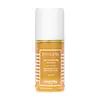What's inside
What's inside
 Key Ingredients
Key Ingredients

 Benefits
Benefits

 Concerns
Concerns

 Ingredients Side-by-side
Ingredients Side-by-side

Butyl Methoxydibenzoylmethane 3%
UV AbsorberEthylhexyl Methoxycinnamate 5%
UV AbsorberEthylhexyl Salicylate 5%
UV AbsorberBenzophenone-3 4%
UV AbsorberWater
Skin ConditioningGlycerin
HumectantButyrospermum Parkii Butter
Skin ConditioningGlyceryl Stearate
EmollientPEG-100 Stearate
Butylene Glycol
HumectantPotassium Cetyl Phosphate
EmulsifyingSilica
AbrasiveStearyl Alcohol
EmollientTocopheryl Acetate
AntioxidantAllantoin
Skin ConditioningPhysalis Alkekengi Calyx Extract
Skin ConditioningCucumis Sativus Fruit Extract
EmollientRhodochrosite Extract
AntioxidantSodium Acryloyldimethyltaurate/Vp Crosspolymer
Emulsion StabilisingXanthan Gum
EmulsifyingPentylene Glycol
Skin ConditioningDisodium EDTA
Sodium Hydroxide
BufferingCitric Acid
BufferingThymus Mastichina Flower Oil
Skin ConditioningSalvia Officinalis Oil
MaskingPhenoxyethanol
PreservativeSorbic Acid
PreservativePotassium Sorbate
PreservativeLinalool
PerfumingLimonene
PerfumingButyl Methoxydibenzoylmethane 3%, Ethylhexyl Methoxycinnamate 5%, Ethylhexyl Salicylate 5%, Benzophenone-3 4%, Water, Glycerin, Butyrospermum Parkii Butter, Glyceryl Stearate, PEG-100 Stearate, Butylene Glycol, Potassium Cetyl Phosphate, Silica, Stearyl Alcohol, Tocopheryl Acetate, Allantoin, Physalis Alkekengi Calyx Extract, Cucumis Sativus Fruit Extract, Rhodochrosite Extract, Sodium Acryloyldimethyltaurate/Vp Crosspolymer, Xanthan Gum, Pentylene Glycol, Disodium EDTA, Sodium Hydroxide, Citric Acid, Thymus Mastichina Flower Oil, Salvia Officinalis Oil, Phenoxyethanol, Sorbic Acid, Potassium Sorbate, Linalool, Limonene
Water
Skin ConditioningEthylhexyl Methoxycinnamate
UV Absorber4-Methylbenzylidene Camphor
UV AbsorberDicaprylyl Carbonate
EmollientBeeswax
Emulsion StabilisingCetearyl Alcohol
EmollientPolyglyceryl-3 Methylglucose Distearate
EmulsifyingStearyl Alcohol
EmollientCaprylic/Capric Triglyceride
MaskingGlyceryl Stearate
EmollientDimethicone
EmollientTocopheryl Acetate
AntioxidantHydrolyzed Collagen
EmollientXanthan Gum
EmulsifyingAloe Barbadensis Leaf Extract
EmollientMorus Alba Bark Extract
Skin ConditioningPanax Ginseng Root Extract
EmollientSimmondsia Chinensis Seed Oil
EmollientPersea Gratissima Oil
Skin ConditioningDisodium EDTA
Dipotassium Glycyrrhizate
HumectantAllantoin
Skin ConditioningArbutin
Antioxidant1,2-Hexanediol
Skin ConditioningParfum
MaskingAdenosine
Skin ConditioningCI 77492
Cosmetic ColorantWater, Ethylhexyl Methoxycinnamate, 4-Methylbenzylidene Camphor, Dicaprylyl Carbonate, Beeswax, Cetearyl Alcohol, Polyglyceryl-3 Methylglucose Distearate, Stearyl Alcohol, Caprylic/Capric Triglyceride, Glyceryl Stearate, Dimethicone, Tocopheryl Acetate, Hydrolyzed Collagen, Xanthan Gum, Aloe Barbadensis Leaf Extract, Morus Alba Bark Extract, Panax Ginseng Root Extract, Simmondsia Chinensis Seed Oil, Persea Gratissima Oil, Disodium EDTA, Dipotassium Glycyrrhizate, Allantoin, Arbutin, 1,2-Hexanediol, Parfum, Adenosine, CI 77492
Ingredients Explained
These ingredients are found in both products.
Ingredients higher up in an ingredient list are typically present in a larger amount.
Allantoin is a soothing ingredient known for its protective and moisturizingg properties. Because of this, it is often added to products with strong active ingredients.
Studies show higher concentrations of this ingredient can promote wound healing.
Though it can be derived from the comfrey plant, allantoin is produced synthetically for cosmetic products to ensure purity.
Learn more about AllantoinDisodium EDTA plays a role in making products more stable by aiding other preservatives.
It is a chelating agent, meaning it neutralizes metal ions that may be found in a product.
Disodium EDTA is a salt of edetic acid and is found to be safe in cosmetic ingredients.
Learn more about Disodium EDTAEthylhexyl Methoxycinnamate is an organic compound that provides UVB protection. It often goes by the more common name of octinoxate. It is created from methoxycinnamic acid and 2-ethylhexanol.
Ethylhexyl Methoxycinnamate absorbs UVB rays with wavelengths between 280-320 nm. UV absorbers protect your skin by using chemical reactions to convert UV rays into heat and energy.
UVB (290-320 nm) rays emit more energy than UVA rays. They are capable of damaging DNA, causing sunburns and are thought to be linked to skin cancer.
The state of Hawaii has banned sunscreens containing octinoxate due to its potential impact on coral reefs. More research is needed to bridge gaps in this research. The European Union allows higher levels of octinoxate in sunscreens than the US and Australia.
Ethylhexyl Methoxycinnamate is oil soluble. It is not stable and may lose efficacy when exposed to sunlight.
Learn more about Ethylhexyl MethoxycinnamateGlyceryl Stearate is a mix of glycerin and stearic acid.
It is used to stabilize the mixing of water and oil ingredients. By preventing these ingredients from separating, it can help elongate shelf life. It can also help thicken the product's texture.
As an emollient, it helps soften skin and supports barrier-replenishing ingredients.
In cosmetics, Glyceryl Stearate is often made from vegetable oils or synthetically produced.
This ingredient may not be fungal-acne safe
Fun fact: The human body also creates Glyceryl Stearate naturally.
Learn more about Glyceryl StearateStearyl Alcohol is a type of fatty alcohol from stearic acid. It is a white, waxy compound used to emulsify ingredients.
Fatty Alcohols are most often used as an emollient or to thicken a product. Emollients help soothe and hydrate the skin by trapping moisture.
They are usually derived from natural fats and oils and therefore do not have the same drying or irritating effect as solvent alcohols. FDA allows products labeled "alcohol-free" to have fatty alcohols.
Learn more about Stearyl AlcoholTocopheryl Acetate is AKA Vitamin E. It is an antioxidant and protects your skin from free radicals. Free radicals damage the skin by breaking down collagen.
One study found using Tocopheryl Acetate with Vitamin C decreased the number of sunburned cells.
Tocopheryl Acetate is commonly found in both skincare and dietary supplements.
Learn more about Tocopheryl AcetateWater. It's the most common cosmetic ingredient of all. You'll usually see it at the top of ingredient lists, meaning that it makes up the largest part of the product.
So why is it so popular? Water most often acts as a solvent - this means that it helps dissolve other ingredients into the formulation.
You'll also recognize water as that liquid we all need to stay alive. If you see this, drink a glass of water. Stay hydrated!
Learn more about WaterXanthan gum is used as a stabilizer and thickener within cosmetic products. It helps give products a sticky, thick feeling - preventing them from being too runny.
On the technical side of things, xanthan gum is a polysaccharide - a combination consisting of multiple sugar molecules bonded together.
Xanthan gum is a pretty common and great ingredient. It is a natural, non-toxic, non-irritating ingredient that is also commonly used in food products.
Learn more about Xanthan Gum